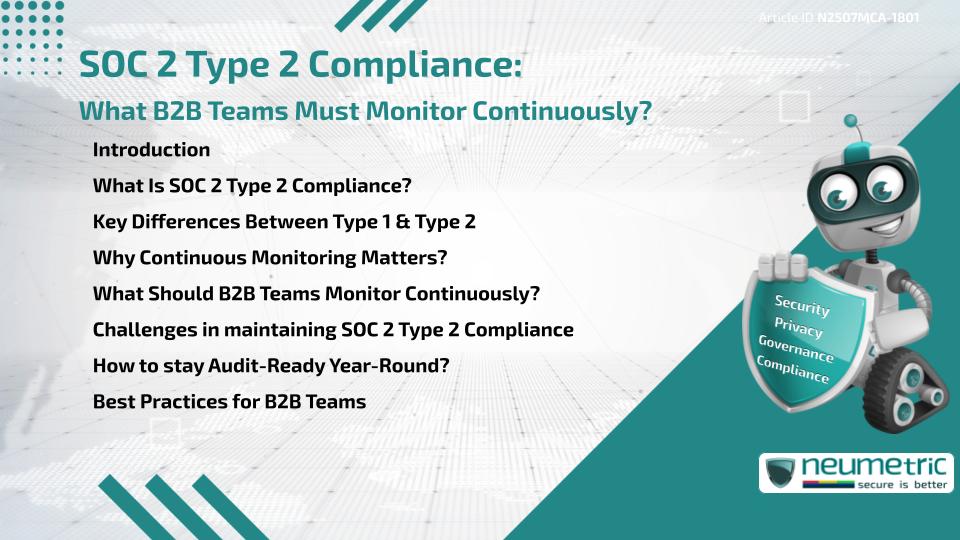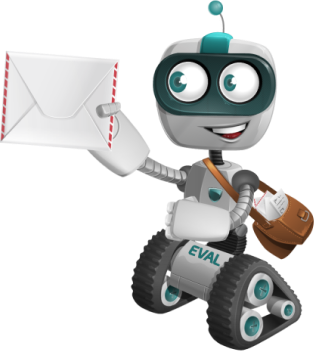Table of Contents
ToggleIntroduction
In today’s security-first business world, trust is no longer optional — especially for B2B companies that manage sensitive Customer Data. SOC 2 Type 2 Compliance has emerged as a trusted Standard that not only ensures Data Protection but also proves operational reliability. However, achieving certification is just the beginning. The real challenge lies in maintaining Compliance through Continuous Monitoring.
This article breaks down what B2B teams need to monitor regularly to uphold SOC 2 Type 2 Compliance & sustain trust across clients, regulators & partners.
What Is SOC 2 Type 2 Compliance?
SOC 2 Type 2 Compliance refers to an Audit Framework designed by the American Institute of Certified Public Accountants [AICPA]. It evaluates how effectively a service Organisation implements & maintains Security Controls over a period of time — usually a minimum of six (6) months.
Unlike Type 1, which assesses controls at a single point, Type 2 verifies the operational consistency & effectiveness of these controls over time.
To comply with SOC 2 Type 2, Organisations must meet criteria in one or more of the Trust Services Criteria:
- Security
- Availability
- Processing Integrity
- Confidentiality
- Privacy
These principles form the backbone of Customer Trust & contractual obligations for B2B vendors.
Learn more about SOC 2 from AICPA’s official page.
Key Differences Between Type 1 & Type 2
While both Type 1 & Type 2 fall under the SOC 2 umbrella, their scope & depth differ significantly:
| Feature | Type 1 | Type 2 |
| Audit Timing | Single point in time | Over six (6) to twelve (12) months |
| Focus | Control design | Control design & operating effectiveness |
| Proof Required | Documented Policies | Real-world evidence like logs & system data |
| Effort Level | Moderate | High & ongoing |
In essence, SOC 2 Type 2 Compliance requires not just intent but proof of consistency.
Why Continuous Monitoring Matters?
SOC 2 Type 2 is all about showing that your security & Privacy practices are not one-time fixes but embedded into everyday Business Operations.
Here is why Continuous Monitoring is critical:
- Threats evolve daily: Static controls can quickly become outdated.
- Real-time visibility: You need immediate insight into unusual activities.
- Audit readiness: Ongoing monitoring reduces last-minute scrambling.
- Customer confidence: Clients value partners who are proactive, not reactive.
What Should B2B Teams Monitor Continuously?
To uphold SOC 2 Type 2 Compliance, B2B teams should actively monitor the following:
1. Access Controls
Track who accesses what, when & from where. This helps detect unauthorsed access & supports the Security criterion.
2. System Changes
Any system-level changes, especially in production, must be logged & reviewed.
3. Incident Response Activities
Monitor how your team handles alerts, breaches or failures — & document your Incident Response actions.
4. Data Backup & Recovery
Ensure regular, tested backups are taking place. Logs should confirm both schedule & success.
5. Network Monitoring
Watch for unusual traffic patterns or unapproved IP addresses which could indicate a breach.
6. Audit Log Reviews
Check log files to confirm control adherence & identify potential anomalies.
7. Vendor Risk Management
Keep tabs on Third Party vendors to ensure they do not compromise your Compliance posture.
Challenges in maintaining SOC 2 Type 2 Compliance
Even with good tools, maintaining SOC 2 Type 2 Compliance comes with challenges:
- Alert fatigue: Too many alerts can overwhelm teams.
- Staff turnover: New staff must be onboarded securely & trained quickly.
- Tool integration: Different tools may not work well together.
- Documentation overload: Every action must be recorded properly.
Overcoming these challenges requires careful planning, delegation & testing.
How to stay Audit-Ready Year-Round?
Being “Audit-ready” means you are always prepared to demonstrate Compliance, even between formal Audits. Here is how:
- Set up automatic alerting & logging.
- Schedule monthly control reviews.
- Assign Compliance responsibilities to team members.
- Create a shared folder of Compliance evidence.
- Conduct mock Audits twice a year.
Best Practices for B2B Teams
To ensure your efforts remain aligned with SOC 2 Type 2 expectations, adopt the following Best Practices:
- Treat Compliance as a culture: Everyone should own security.
- Review controls quarterly: Do not wait for auditors to find issues.
- Communicate incidents: Transparency helps strengthen response processes.
- Simplify documentation: Use templates & Standard formats.
Takeaways
- SOC 2 Type 2 Compliance verifies how consistently Security Controls operate.
- B2B teams must monitor systems, access & incidents continuously.
- Tools like SIEM & IAM systems simplify monitoring & reporting.
- A Compliance-first culture enables long-term success.
FAQ
Why do we need both SOC 2 Type 1 & Type 2?
Type 1 is required for evaluating control design at a specific moment, while Type 2 assesses how effectively those controls work over time.
Why does SOC 2 Type 2 Compliance need Continuous Monitoring?
Because it proves that your controls do not just exist — they actually work consistently every day.
Do all B2B companies need SOC 2 Type 2 Compliance?
No, but many clients demand it before signing contracts, especially in SaaS & cloud-based services.
How much time is needed to achieve SOC 2 Type 2 Compliance?
Usually six (6) to twelve (12) months, depending on control maturity & team readiness.
What tools are most helpful for monitoring SOC 2 Type 2 controls?
SIEM tools, IAM platforms, Audit readiness software & cloud Compliance tools help track controls effectively.
Is it possible for internal teams to handle SOC 2 Type 2 Compliance alone?
They can, but Third Party help may be useful for Audits, Gap Analysis & automation.
Can an Organisation lose SOC 2 Type 2 Compliance?
Yes. Failing to maintain control performance or missing Audit requirements can lead to non-Compliance.
Does SOC 2 Type 2 Compliance include Privacy requirements?
Only if the Organisation chooses to include the Privacy trust principle in scope.
Need help?
Neumetric provides organisations the necessary help to achieve their Cybersecurity, Compliance, Governance, Privacy, Certifications & Pentesting goals.
Organisations & Businesses, specifically those which provide SaaS & AI Solutions, usually need a Cybersecurity Partner for meeting & maintaining the ongoing Security & Privacy needs & requirements of their Clients & Customers.
SOC 2, ISO 27001, ISO 42001, NIST, HIPAA, HECVAT, EU GDPR are some of the Frameworks that are served by Fusion – a centralised, automated, AI-enabled SaaS Solution created & managed by Neumetric.
Reach out to us!


